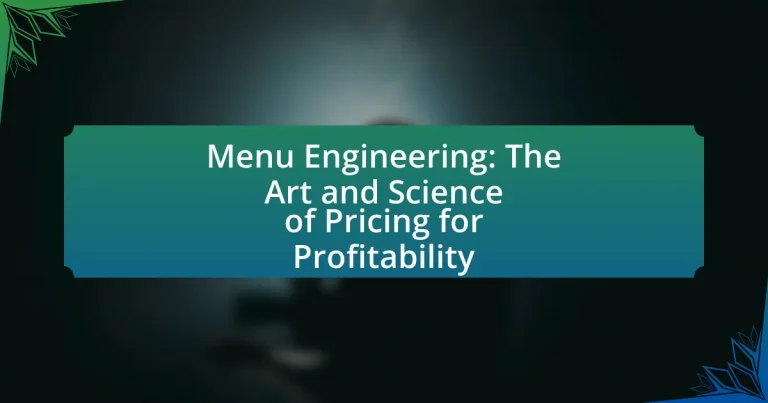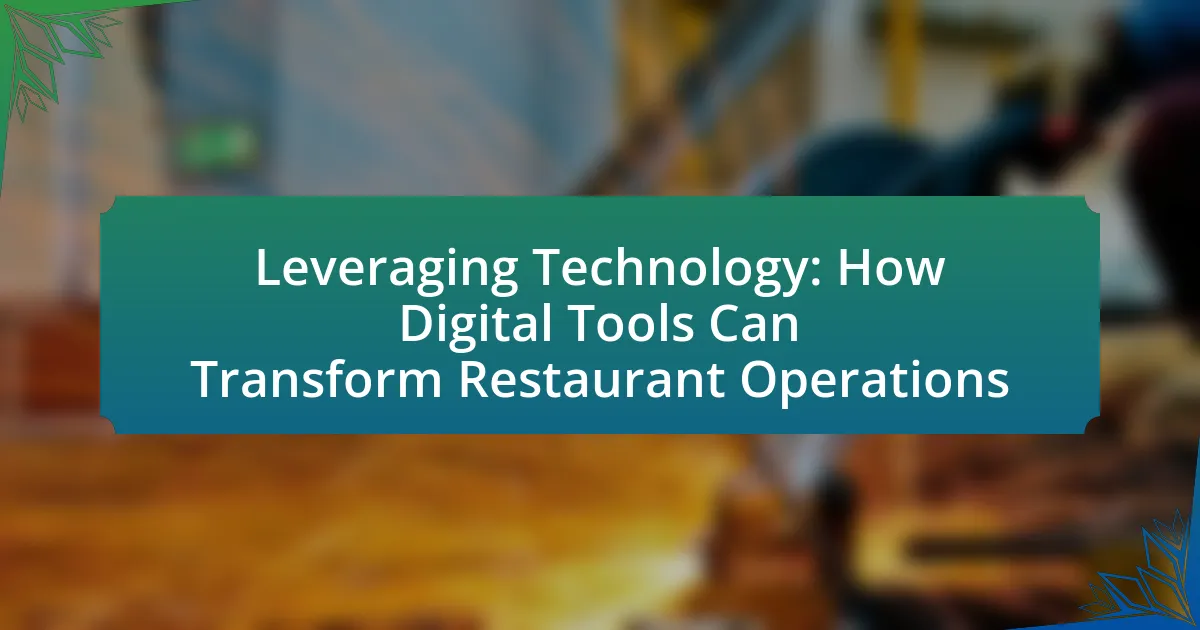Menu engineering is a systematic approach to designing and optimizing restaurant menus to maximize profitability and enhance customer satisfaction. The article explores how menu engineering impacts restaurant profitability through strategic item placement, pricing psychology, and menu design, leading to potential sales increases of 10-15%. Key principles include analyzing food costs, contribution margins, and customer preferences, while differentiating menu engineering from traditional design methods. Additionally, it discusses the importance of continuous evaluation, market research, and best practices to improve menu performance and customer experience, ultimately driving revenue in the competitive food service industry.

What is Menu Engineering?
Menu engineering is the systematic approach to designing and optimizing a restaurant’s menu to maximize profitability and enhance customer satisfaction. This process involves analyzing the popularity and profitability of menu items, categorizing them, and strategically placing them to influence customer choices. Research indicates that effective menu engineering can increase sales by up to 15% by guiding customers toward higher-margin items through layout, descriptions, and pricing strategies.
How does Menu Engineering impact restaurant profitability?
Menu engineering significantly enhances restaurant profitability by optimizing menu design and pricing strategies to maximize sales and margins. By analyzing the popularity and profitability of menu items, restaurants can strategically position high-margin items, promote them effectively, and adjust pricing based on customer preferences and cost structures. Research indicates that restaurants employing menu engineering techniques can see profit increases of 10% to 15% by focusing on item placement, descriptions, and pricing psychology. This approach not only drives sales but also improves customer satisfaction by aligning offerings with consumer demand.
What are the key principles of Menu Engineering?
The key principles of Menu Engineering include understanding the psychology of pricing, analyzing food cost and contribution margin, and strategically designing the menu layout. Pricing psychology involves using techniques such as charm pricing and price anchoring to influence customer choices. Analyzing food cost ensures that each menu item is profitable, while contribution margin analysis helps identify which items contribute most to overall profitability. Additionally, menu layout design, including the placement of high-margin items in prominent positions, can significantly impact sales. These principles are supported by research indicating that effective menu engineering can increase restaurant profitability by up to 15%.
How does Menu Engineering differ from traditional menu design?
Menu Engineering differs from traditional menu design by focusing on the profitability and sales performance of menu items rather than solely on aesthetics or culinary appeal. While traditional menu design often emphasizes visual presentation and thematic elements, Menu Engineering employs analytical techniques to categorize items based on their contribution margin and popularity, allowing restaurants to optimize pricing strategies and item placement for maximum profitability. This approach is supported by data analysis, which reveals that items classified as “stars” (high popularity and high profitability) should be highlighted, while “dogs” (low popularity and low profitability) may need to be reconsidered or removed.
Why is Menu Engineering important for food service businesses?
Menu engineering is important for food service businesses because it optimizes menu design to enhance profitability and customer satisfaction. By analyzing sales data and food costs, businesses can identify high-margin items and strategically position them on the menu to increase sales. Research indicates that effective menu engineering can lead to a 10-15% increase in overall sales, as it influences customer choices and enhances perceived value. This strategic approach not only maximizes revenue but also helps in managing food costs effectively, ensuring long-term sustainability in a competitive market.
What role does pricing play in Menu Engineering?
Pricing plays a critical role in Menu Engineering by directly influencing customer purchasing decisions and overall profitability. Effective pricing strategies can enhance perceived value, encourage upselling, and optimize menu item placement, ultimately leading to increased sales. Research indicates that menu items priced strategically can boost revenue by as much as 10-15%, demonstrating the significant impact of pricing on financial performance in the restaurant industry.
How can Menu Engineering enhance customer experience?
Menu Engineering enhances customer experience by strategically designing menus that highlight high-margin items and improve decision-making. This approach utilizes psychological principles, such as the placement of items and descriptive language, to guide customers toward desirable choices. Research indicates that well-engineered menus can increase customer satisfaction by reducing choice overload and enhancing perceived value, ultimately leading to higher sales and repeat visits. For example, a study published in the Journal of Foodservice Business Research found that menus designed with clear categories and appealing descriptions resulted in a 20% increase in customer spending.

What are the components of Menu Engineering?
The components of Menu Engineering include menu design, item pricing, item placement, and analysis of item performance. Menu design focuses on the visual appeal and layout of the menu, which influences customer choices. Item pricing involves setting prices based on cost, competition, and perceived value to maximize profitability. Item placement refers to strategically positioning high-margin items to attract attention and encourage sales. Analysis of item performance utilizes sales data to evaluate which items are popular and profitable, guiding future menu adjustments. These components work together to enhance profitability and customer satisfaction in the dining experience.
How do menu items influence Menu Engineering strategies?
Menu items significantly influence Menu Engineering strategies by determining pricing, placement, and promotion tactics that maximize profitability. The characteristics of each menu item, such as food cost, popularity, and contribution margin, guide decisions on how to categorize and highlight items. For instance, high-margin items are often placed in prominent positions on the menu to attract customer attention, while low-margin items may be strategically positioned to complement higher-margin offerings. Research indicates that menu items with higher perceived value can lead to increased sales, as demonstrated by a study published in the Journal of Foodservice Business Research, which found that menu design and item placement can enhance customer purchasing behavior. Thus, the selection and arrangement of menu items are critical components in developing effective Menu Engineering strategies that drive revenue.
What factors determine the pricing of menu items?
The pricing of menu items is determined by factors such as ingredient costs, labor expenses, market demand, competition, and perceived value. Ingredient costs directly influence the base price, as higher quality or specialty ingredients typically lead to increased prices. Labor expenses, including preparation and service, also contribute to overall pricing. Market demand affects pricing strategies; items in high demand may be priced higher. Competition requires restaurants to consider similar offerings and their prices to remain competitive. Lastly, perceived value, influenced by presentation and branding, can justify higher prices for certain items.
How can item placement affect sales and profitability?
Item placement significantly affects sales and profitability by influencing customer purchasing behavior. Strategic positioning of items, such as placing high-margin products at eye level or near the checkout, can increase visibility and encourage impulse buys. Research indicates that products placed in prominent locations can see sales increases of up to 30%. Additionally, studies show that customers are more likely to purchase items that are easily accessible and attractively displayed, leading to higher overall profitability for businesses.
What types of analysis are used in Menu Engineering?
Menu engineering employs several types of analysis, primarily including contribution margin analysis, menu item popularity analysis, and menu mix analysis. Contribution margin analysis evaluates the profitability of each menu item by calculating the difference between the selling price and the cost of goods sold. Menu item popularity analysis assesses the sales volume of each item to identify bestsellers and underperformers. Menu mix analysis examines the overall composition of the menu to ensure a balanced offering that maximizes customer satisfaction and profitability. These analyses collectively inform strategic decisions regarding pricing, placement, and promotion of menu items to enhance profitability.
What is the contribution margin analysis?
Contribution margin analysis is a financial assessment that determines the profitability of individual items by calculating the difference between sales revenue and variable costs associated with producing those items. This analysis helps businesses identify which products contribute most to overall profit, guiding pricing and menu design decisions. For instance, if a restaurant sells a dish for $20 and incurs $8 in variable costs, the contribution margin is $12, indicating that each sale contributes $12 towards covering fixed costs and generating profit.
How does the menu mix analysis work?
Menu mix analysis evaluates the performance of menu items based on their popularity and profitability. This analysis categorizes items into four quadrants: stars (high popularity and high profitability), plowhorses (high popularity but low profitability), dogs (low popularity and low profitability), and puzzles (low popularity but high profitability). By assessing these categories, restaurants can make informed decisions about menu design, pricing strategies, and promotional efforts to enhance overall profitability. For instance, a study by Kwortnik and Thompson (2009) in the Journal of Service Research highlights that effective menu mix analysis can lead to improved sales and customer satisfaction by aligning offerings with consumer preferences.

How can Menu Engineering be implemented effectively?
Menu Engineering can be implemented effectively by analyzing menu item performance through sales data and profitability metrics. This involves categorizing items into four groups: stars, plowhorses, puzzles, and dogs, based on their popularity and contribution to profit. By adjusting pricing, placement, and descriptions of menu items according to their category, restaurants can enhance customer choices and increase overall profitability. Research indicates that strategic menu design can lead to a 10-15% increase in sales, demonstrating the effectiveness of these methods in optimizing menu performance.
What steps should be taken to create a profitable menu?
To create a profitable menu, restaurants should conduct a thorough analysis of food costs, pricing strategies, and customer preferences. First, calculate the food cost percentage for each menu item by dividing the cost of ingredients by the selling price, aiming for a target of 28-35% for optimal profitability. Next, implement psychological pricing techniques, such as pricing items just below whole numbers (e.g., $9.99 instead of $10) to enhance perceived value. Additionally, analyze sales data to identify high-margin items and promote them prominently on the menu. Finally, regularly update the menu based on seasonal ingredients and customer feedback to maintain relevance and appeal. These steps are supported by industry standards indicating that effective menu engineering can increase profitability by 10-15%.
How can market research inform Menu Engineering decisions?
Market research can significantly inform Menu Engineering decisions by providing insights into customer preferences, competitive pricing, and market trends. By analyzing data from surveys, focus groups, and sales reports, restaurants can identify which menu items are most popular and profitable. For instance, a study by the National Restaurant Association found that 70% of consumers are influenced by menu descriptions, indicating that understanding customer preferences can enhance menu appeal and drive sales. Additionally, market research helps in determining optimal pricing strategies by evaluating competitor prices and consumer willingness to pay, ensuring that menu items are priced competitively while maximizing profitability.
What tools and software can assist in Menu Engineering?
Tools and software that assist in Menu Engineering include menu design software, pricing analysis tools, and inventory management systems. Menu design software like MenuPro and Canva allows restaurants to create visually appealing menus that enhance customer experience. Pricing analysis tools such as MenuCalc and Food Cost Pro help in determining optimal pricing strategies based on food costs and profit margins. Inventory management systems like MarketMan and BlueCart streamline ingredient tracking and cost control, ensuring that menu items remain profitable. These tools collectively enhance the efficiency and effectiveness of menu engineering by providing data-driven insights and facilitating better decision-making.
What common mistakes should be avoided in Menu Engineering?
Common mistakes to avoid in Menu Engineering include neglecting to analyze food cost percentages, failing to consider customer preferences, and not updating the menu regularly. Neglecting food cost analysis can lead to pricing items too low, resulting in reduced profitability; for instance, a dish with a food cost of 30% should ideally be priced to achieve a 70% contribution margin. Ignoring customer preferences can result in low sales for certain items, as menus should reflect what customers want rather than solely what the chef prefers. Lastly, not updating the menu regularly can cause stagnation, as trends and customer tastes evolve; research indicates that menus should be refreshed at least annually to maintain relevance and appeal.
How can overpricing or underpricing affect sales?
Overpricing can lead to decreased sales as consumers may perceive the product as not providing value for the cost, resulting in lower demand. Conversely, underpricing can also negatively impact sales by creating a perception of lower quality or unsustainability, which may deter customers who associate price with value. Research indicates that products priced too high can see a significant drop in sales volume; for example, a study by the Journal of Marketing found that a 10% increase in price can lead to a 20% decrease in sales for certain consumer goods. Similarly, underpricing can lead to reduced profitability, as seen in the food industry where restaurants that price items too low may struggle to cover costs, ultimately affecting their sales volume and brand perception.
What are the pitfalls of neglecting customer preferences?
Neglecting customer preferences can lead to decreased customer satisfaction and loyalty. When businesses fail to consider what customers want, they risk losing repeat business, as 70% of consumers are more likely to remain loyal to brands that understand their preferences. Additionally, ignoring these preferences can result in poor sales performance, as products that do not align with customer desires are less likely to be purchased. This misalignment can also lead to increased inventory costs and waste, as unsold items accumulate. Ultimately, neglecting customer preferences undermines profitability and can damage a brand’s reputation in a competitive market.
What are best practices for successful Menu Engineering?
Best practices for successful menu engineering include analyzing food cost percentages, utilizing psychological pricing strategies, and designing visually appealing layouts. Analyzing food cost percentages ensures that each menu item contributes to profitability; for instance, items with a food cost of 30% or lower are generally more profitable. Psychological pricing strategies, such as pricing items just below a whole number (e.g., $9.99 instead of $10), can influence customer perception and increase sales. Additionally, a visually appealing layout that highlights high-margin items through strategic placement and design can drive customer choices, as studies show that items placed at the top right of a menu are often the first to be noticed. These practices collectively enhance profitability and customer satisfaction in menu engineering.
How can continuous menu evaluation improve profitability?
Continuous menu evaluation improves profitability by enabling restaurants to identify high-performing items and eliminate underperformers. This process involves analyzing sales data, customer preferences, and food costs to optimize the menu. For instance, a study by the National Restaurant Association found that restaurants that regularly update their menus can increase sales by up to 15%. By focusing on popular dishes and adjusting pricing strategies based on demand, establishments can enhance customer satisfaction and maximize revenue.
What strategies can enhance menu item visibility and appeal?
To enhance menu item visibility and appeal, restaurants can utilize strategic placement, descriptive language, and visual elements. Strategic placement involves positioning high-margin items at eye level or in prime locations on the menu, which increases the likelihood of customer selection. Descriptive language that highlights unique ingredients or preparation methods can evoke sensory responses, making items more enticing. Additionally, incorporating visual elements such as images or icons can draw attention to specific dishes, further enhancing their appeal. Research indicates that menus with appealing descriptions can increase sales by up to 27%, demonstrating the effectiveness of these strategies in driving customer choices.




